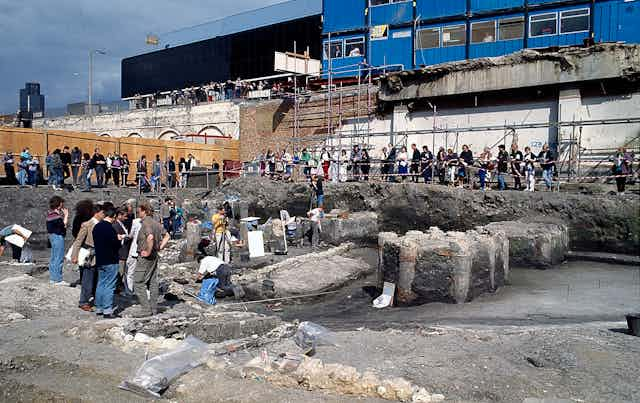Before The Globe, there was The Rose: one of the first purpose-built theatres on London’s Southbank. William Shakespeare’s plays first gained sell-out success on the stage of The Rose. But as other, rival theatre spaces emerged, it fell out of favour. It was abandoned by 1606, and eventually vanished underneath newer layers of London.
All seemed lost, until in 1988, when the owners of Southern House – an uninspiring 1957 office block on Rose Alley – gained planning permission to redevelop the site after agreeing to a routine two-month archaeological dig. In January 1989, near the end of the dig, The Rose was rediscovered, to the astonishment and delight of archaeologists, historians, thespians and theatre lovers.
It became the first Shakespearean theatre to be archaeologically excavated, revealing a classic 14-sided polygon structure, with galleries and an uncovered yard, where poorer viewers could stand in front of the stage. It remains one of the best-preserved and most informative theatre excavations; The Times described it as the “most exciting archaeological find since Tutankhamun”.
But the archaeologists soon faced a thorny problem: technically, because planning permission had already been granted, the construction of the new building could proceed without any further archaeological work.
Save the Rose

Understandably, the acting and theatre community wished to see The Rose preserved. Sir Laurence Olivier gathered support, and household names such as Sir Ian McKellen, Dame Judy Dench, Sir Patrick Stewart, Dame Peggy Ashcroft and Alan Rickman joined the “Save the Rose” campaign. American actor Dustin Hoffman even flew over from the US, to see The Rose excavations and lend his support.
The government could have halted the development and preserved The Rose, by declaring it a scheduled ancient monument – this would have put it on the same footing as Stonehenge. But given the cost of compensating the developer, it declined to do so.
Initially, small extensions were given to the archaeologists to continue excavations. Over time, more and more campaigners gathered outside the building site, culminating with an all-night vigil on May 12 1989 to turn away building contractors. The campaign worked: a further six month excavation took place, and the new building was altered to allow The Rose to be preserved underneath, where it can still be visited to this day.

In the end, the developer and government spent an additional £11m on further archaeological research and redesigned the new building to accommodate the theatre. As many archaeologists pointed out, if an assessment had taken place before planning permission was granted, the developer could have made plans for the archaeological work and possible building alterations. The Rose was one of a number of sites to encounter this problem.
A year later the government introduced new planning guidance, which fundamentally changed the role of archaeologists. Under the new guidance (and its subsequent replacements), archaeology became part of the planning process. Site assessments by archaeological professionals prior to planning permission became the norm.
Still in danger
But today, the proposed Neighbourhood Planning and Infrastructure Bill could raise the same problems all over again. As part of a drive to build 250,000 much-needed new homes a year, the bill aims to “reform and speed up the planning process by minimising delays caused by pre-commencement planning conditions”. In particular, The Telegraph suggests that “archaeological and wildlife surveys” will be “swept away” once this law is passed. This could very well put archaeological sites in danger of destruction, or risk great costs to developers.
Archaeological organisations have mobilised, seeking confirmation of the government’s intentions. Already, a petition to parliament highlighting the danger to archaeology has gathered more than 13,000 signatures. Archaeological newsletters suggest that archaeologists feel they are being used as scapegoats for the housing crisis.
In fact, there are many other factors which have contributed to the UK’s housing shortage. In reality, less than 1% of planning applications need archaeological work to take place – so getting rid of the guidance is unlikely to fast-track a vast swathe of projects. And doing this work before granting planning permission ensures that there are no expensive delays or surprises for the developer.
Many exciting archaeological discoveries have rewritten England’s story since the discovery of The Rose – the majority due to planning conditions. Indeed, another Elizabethan theatre – The Curtain in London – is currently being excavated. In this case, archaeologists got involved early in the planning process; evaluating the site, undertaking trial excavations and enabling the archaeology to take centre stage in the development.
Removing or watering down archaeology’s place in the planning process will undoubtedly lead future generations to ask once more – how was this situation allowed to occur?

